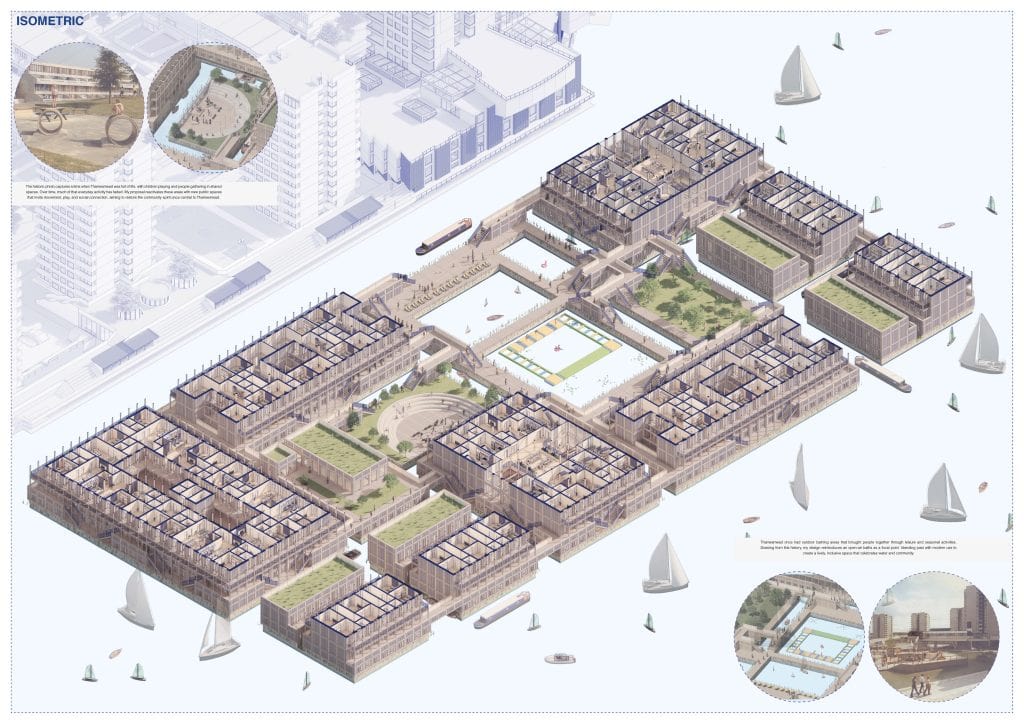Buoyant Living: Floating Futures for Thamesmead
Rethinking Urban Resilience in the Face of London’s Flood Risks
With the climate emergency shifting from distant threat to present reality, cities like London find themselves at a turning point—caught between growing populations and rising tides. In the midst of this challenge, Gagandeep Sandhu, a recent Part I Architecture graduate from the University of Nottingham, offers a visionary response steeped in both environmental pragmatism and social ambition. His final-year thesis, an award-winning exploration of flood-resilient floating housing for Thamesmead, stands out for its bold reimagining of how Londoners could live safely and sustainably in a water-threatened future.
Award-Winning Academic Foundations
Sandhu’s academic prowess is already well established. Graduating with First Class Honours, he earned the Housing Prize for Part I and was shortlisted for the esteemed Third Year Portfolio Prize, receiving both a nomination and a commendation. These accolades reflect not only a mastery of design craft but also a capacity to interrogate complex urban problems with both creative verve and methodical rigor.
Currently seeking Part I opportunities to apply his thinking in the professional realm, Sandhu brings to the table a track record of design excellence and a deep commitment to translating academic discourse into tangible, real-world impact.
Project Genesis: Thamesmead’s Vulnerable Edge
At the heart of Sandhu’s project is a sharp understanding of place. Thamesmead, a district straddling the southeastern flank of London, has long grappled with both its low-lying topography and socio-economic disadvantage. Projections suggest that by the 2080s, rising sea levels and more severe weather could place over 1.25 million Londoners, along with major infrastructure—schools, hospitals, the Underground—at risk of catastrophic flooding. In this context, mere fortification of the existing landscape seems insufficient.
Instead, Sandhu proposes an adaptive, amphibious solution: an interconnected community of floating homes that turn vulnerability into an asset.
Floating Architecture: Beyond Flood Defence
The project challenges preconceived notions of housing “against” water by embracing a model that cohabits with it. Modular timber-clad dwellings are engineered to rise and fall with fluctuating water levels, tethered to resilient piles and utility pontoons. Landscaped communal decks unfold across a flexible grid of floating platforms, providing both private retreats and shared public amenities.
Crucially, this isn’t just a technical fix. The scheme is rooted in the rhythms of local life, supporting diverse household types—including families, older residents, and single professionals—and promoting social cohesion through a blend of private gardens and collective courtyards.
Sustainability is embedded at every level: green roofs, integrated solar panels, rainwater harvesting, and constructed wetlands ensure that each home is part of a living ecosystem rather than an isolated structure. The floating community plugs into existing Thamesmead neighbourhoods, reconnecting them to the shoreline and treating the urban realm as a gradient—where land and water, nature and infrastructure, blend seamlessly.
A Model for Climate-Resilient Urbanism
Rather than a one-off intervention, Sandhu’s thesis envisions a repeatable prototype—a toolkit for cities worldwide on the frontlines of climate change. By transforming at-risk land into an asset, the scheme offers a viable alternative to displacement or ever-escalating defences, positioning flood adaptation as an opportunity to add housing, public space, and ecological value simultaneously.
The flexibility of the floating structures allows for future expansion and reconfiguration, adapting to demographic and environmental shifts. Meanwhile, the community’s embeddedness in local economies—incorporating workspace pods, floating markets, and educational hubs—bolsters its long-term viability.
Human Stories, Global Relevance
What sets the proposal apart is its blend of urban scale thinking and individual narrative. Renderings depict sunlit interiors with river views, vibrant markets along floating promenades, and sheltered communal gardens where children play safely above fluctuating tides. Residents aren’t merely “protected” from water; they are enabled to thrive alongside it.
Sandhu draws inspiration from the historical symbiosis between Londoners and the Thames, reinventing ancient relationships for a new climate epoch. In doing so, he advances a vision both locally rooted and globally applicable—a template for adaptive living that shifts the conversation from defensive reaction to proactive resilience.
Engage with the Designer
Gagandeep Sandhu’s thesis is more than a speculative proposal; it is a clarion call for architects, planners, and policymakers to think ambitiously and act decisively in the face of environmental precarity. As he seeks industry experience to further develop his ideas, Sandhu invites dialogue and collaboration with professionals passionate about sustainable, future-oriented design.
To connect with Gagandeep Sandhu, visit his LinkedIn profile or reach out via email at sandhugagandeep44@gmail.com.
In floating housing, we glimpse not just a technical solution, but a new social contract—one in which cities rise, quite literally, to meet their greatest challenges. With emerging talent like Sandhu at the helm, London’s architectural future looks buoyant indeed.











Add a comment